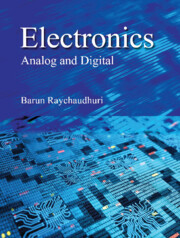Book contents
Summary
The modern computer is such as electronic gadget where all of the analog and digital electronic devices mentioned in this book are included somewhere or else. This chapter presents a brief idea on the basic principles and architectural blocks of a computer. The role of microprocessor in computer and the fundamentals of programming the microprocessor are interpreted using 8085 as a model.
Evolution of Computer
The modern computer evolved as an electronic instrument and got so much involved in scientific, technical, commercial, and household applications that it gave birth to computer science as a separate subject. Anyway the first computer was not electronic but a mechanical instrument. Indeed performing mathematical calculations with instruments is quite an ancient concept. The word ‘calculate’ is derived from the Latin word calculos, which means stone. Pieces of stone, pebbles, digits of fingers, knot of ropes, nodes of sticks and many other diversified equipment have been employed in arithmetic calculations in different ages of human civilization.
Historical Background
The first known calculating machine is abacus, which was popular in ancient China, Japan, Egypt, and also different countries of Europe. The earlier version of abacus consisted of slotted earthen flats over which pebbles were moved to indicate number positions. The later versions comprised of beads penetrated into framed wires. Table 17.1 outlines a brief sketch of the development of computational concepts and instruments till the middle of the twentieth century.
Charles Babbage, as mentioned in the table, was the first to incorporate all the basic features of a modern computer in his instrumentation. He constructed a large mechanical system named Difference Engine that possessed the following components.
• Mill: It was capable of executing arithmetic processors. It may be compared to the arithmetic logic unit (ALU) of a modern computer.
• Store: It could store numbers, analogous to the memory of today's computer.
• In/Out Ports: There were separate ports for giving instructions and obtaining results, similar to the input and output terminals of a modern computer.
- Type
- Chapter
- Information
- Electronics , pp. 637 - 678Publisher: Cambridge University PressPrint publication year: 2023



